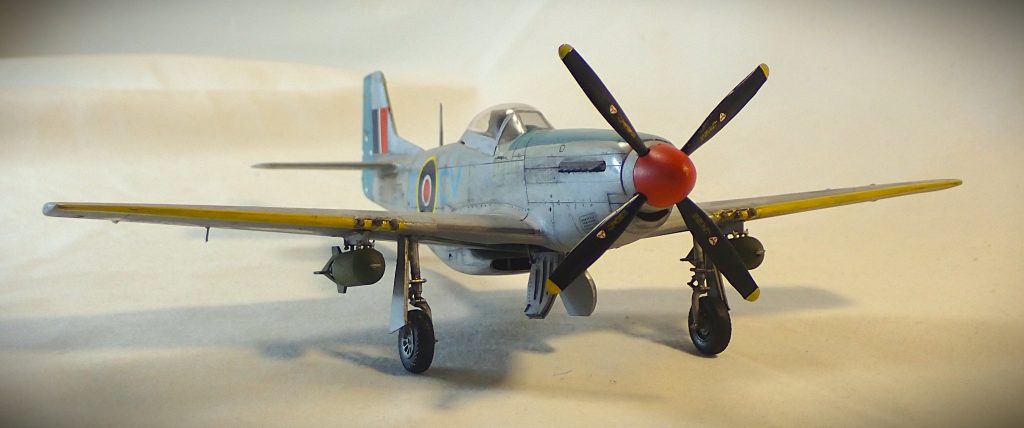This iconic American aircraft was used very early on in the conflict by the RAF. The Mustang was designed and named for the RAF by North American Aircraft as a better alternative to the P-40 which had been ordered. Rather than build an improved P-40 under license NAA designed a new fighter with Air Ministry specs. At this stage it was not a P-51 but the NA-73 and NA-83, 620 in total, given the name Mustang I by the RAF. After the introduction of the Lend Lease Act the designation of P-51 was used as all Lend Lease aircraft were registered as American. Another 140 were supplied to the RAF as Mustang II. The Mustang I entered service with the RAF in early 1941 followed by the Mustang II, both remained in service throughout the war being retired in 1945. It was not until late 1943 that the USAAF began using the P-51 in large numbers as a fighter escort for the Eighth Air Force.
The initial order was powered by the Allison V-1710 engine which, like the P-40, lacked the two-speed supercharger giving it poor performance at higher altitudes. However, it was a much better aircraft than the P-40 in several other aspects. It was armed with six .303 Browning, two in each wing and two in the nose with under belly and wing pylons for combination bomb/drop tank configuration. It was larger and faster than the P-40 at 390mph with a range of 750 miles, double that with drop tanks fitted. 1,500 were built, mainly for the RAF. 620 were delivered as the Mustang I closely followed by 93 Mustang Ia and 50 Mustang II.
In 1942 the P-51 Mustang was upgraded with the Packard Merlin 65 engine with two stage supercharger which vastly improved performance especially above 16,000ft. The P-51B and P-51C were the next two production aircraft with 944 being supplied under Lend Lease to the RAF as Mustang III with the Packard Merlin 66 supercharged engine and improved armament of four .50 Browning AN/M2 machine guns, 2 in each wing with the nose guns removed. The definitive production P-51D, with the bubble sliding canopy and six .50 Browning, was by now being produced mainly for the USAAF. Over 8,200 of these were produced but only 824 were supplied to the RAF as the Mustang IVa and IVb.
Mustangs were used by the RAF mainly on the European front. The first to equip was 26 Squadron in January 1941 as an army cooperation squadron flying recon missions and low-level attack sorties. By 1942 another 15 squadrons were equipped with the Mustang I and Mustang II. In 1943 the squadrons were reequipped with the Mustang III and changed to long range escort and fighter patrols. 26 Squadron continued with the Mustang I until the end of the war as the type was ideal for combatting the V-1 threat as well as recon missions for V-2 sites.
The Mustang III squadrons were initially used as long-range escort fighters for American daylight bombing raids but once the USAAF had sufficient P-51D the British Mustangs were used for escort and fighter patrols over Northern Europe for Bomber Command. During the build up to D-Day many of the Mustang squadrons flew support and ground attack missions providing a fighter screen during Operation Overlord and the weeks that followed. Once Northern France was secured the Mustangs were transferred to bases on the continent and used effectively for support, ground attack and escort missions. In July 1944 half the force was moved back to England to deal with the V-1 threat but returned to France later in the year. The Mustang was also used extensively in The Mediterranean Theatre in similar roles.
100 Mustang IV were exported in kit form to Australia with a further 200 being produced by CAC, Commonwealth Aircraft Company, who built Mustang IVs under licence as well as other British and American aircraft like the Beaufighter, Mosquito and P-40. South Africa and Canada also used the Mustang III and IV.
After the war ended many of the Lend Lease aircraft were returned to America or scrapped by the RAF. Most of the remaining Mustang I’s and II’s were scrapped as they were worn out. A few Mustang IVs were retained in squadron service until 1947 when the Mustang was finally retired from RAF service.
There are a multitude of surviving aircraft all over the world including a large number of airworthy examples mainly in America. In the UK there are sadly no examples of the Mustang I or II. There are four airworthy P-51D’s and four on static display with another four under restoration to airworthy.
